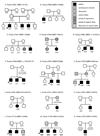Novel variants identified in methyl-CpG-binding domain genes in autistic individuals
- PMID: 19921286
- PMCID: PMC2941261
- DOI: 10.1007/s10048-009-0228-7
Novel variants identified in methyl-CpG-binding domain genes in autistic individuals
Abstract
Misregulation of the methyl-CpG-binding protein 2 (MECP2) gene has been found to cause a myriad of neurological disorders including autism, mental retardation, seizures, learning disabilities, and Rett syndrome. We hypothesized that mutations in other members of the methyl-CpG-binding domain (MBD) family may also cause autistic features in individuals. We evaluated 226 autistic individuals for alterations in the four genes most homologous to MECP2: MBD1, MBD2, MBD3, and MBD4. A total of 46 alterations were identified in the four genes, including ten missense changes and two deletions that alter coding sequence. Several are either unique to our autistic population or cosegregate with affected individuals within a family, suggesting a possible relation of these variations to disease etiology. Variants include a R23M alteration in two affected half brothers which falls within the MBD domain of the MBD3 protein, as well as a frameshift in MBD4 that is predicted to truncate almost half of the protein. These results suggest that rare cases of autism may be influenced by mutations in members of the dynamic MBD protein family.
Figures


References
-
- Johnson CP, Myers SM. American academy of pediatrics council on children with disabilities: identification and evaluation of children with autism spectrum disorders. Pediatrics. 2007;120(5):1183–1215. - PubMed
-
- Fombonne E. Epidemiological trends in rates of autism. Mol Psychiatry. 2002;7 Suppl 2:S4–S6. - PubMed
-
- Autism and Developmental Disabilities Monitoring Network Surveillance Year 2002 Principal Investigators, Centers for Disease Control and Prevention: prevalence of autism spectrum disorders—autism and developmental disabilities monitoring network, 14 sites, United States, 2002. MMWR Surveill Summ. 2007;56(1):12–28. - PubMed
-
- Ritvo ER, Freeman BJ, Mason-Brothers A, Mo A, Ritvo AM. Concordance for the syndrome of autism in 40 pairs of afflicted twins. Am J Psychiatry. 1985;142:74–77. - PubMed
-
- Bailey A, Le Couteur A, Gottesman I, Bolton P, Simonoff E, Yuzda E, Rutter M. Autism as a strongly genetic disorder: evidence from a British twin study. Psychol Med. 1995;25:63–77. - PubMed
Publication types
MeSH terms
Substances
Grants and funding
LinkOut - more resources
Full Text Sources
Research Materials
Miscellaneous

